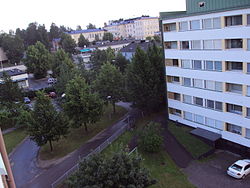Suburb


A suburb (or suburban area or suburbia) is a commercial, mixed-use or residential area.[1][2] It can exist either as part of a city/urban area and can often have a large degree of employment.[3][4] In some metropolitan areas they exist as separate residential communities within commuting distance of a city. Suburbs might have their own political or legal jurisdiction, especially in the United States, but this is not always the case, especially in the United Kingdom where most suburbs are located within the administrative boundaries of cities.[5] In most English-speaking countries, suburban areas are defined in contrast to central or inner city areas, but in Australian English and South African English, suburb has become largely synonymous with what is called a "neighborhood" in other countries, and the term encompasses inner city areas.[citation needed]
In some areas, such as Australia, India, China, New Zealand, Canada, the United Kingdom, and parts of the United States, new suburbs are routinely annexed by adjacent cities due to urban sprawl. In others, such as Morocco, France, and much of the United States, many suburbs remain separate municipalities or are governed locally as part of a larger metropolitan area such as a county, district or borough. In the United States, regions beyond the suburbs are exurbs or "exurban areas", with less population density (but still more than rural areas) but linked to the metropolitan area economically, particularly by commuters.
Suburbs first emerged on a large scale in the 19th and 20th centuries as a result of improved rail and road transport, which led to an increase in commuting.[6] In general, they are less densely populated than inner city neighborhoods within the same metropolitan area, and most residents routinely commute to city centers or business districts via private vehicles or public transits; however, there are many exceptions, including industrial suburbs, planned communities and satellite cities. Suburbs tend to proliferate around cities that have an abundance of adjacent flat land.[7]
Etymology and usage
The English word is derived from the Old French subburbe, which is in turn derived from the Latin suburbium, formed from sub (meaning "under" or "below") and urbs ("city"). The first recorded usage of the term in English, was by John Wycliffe in 1380, when the form subarbis was used, according to the Oxford English Dictionary.
In Australia and New Zealand

In Australia and also New Zealand, suburban areas (in the wider sense noted in the lead paragraph) have become formalised as geographic subdivisions of a city and are used by postal services in addressing. In rural areas in both countries, their equivalents are called localities (see suburbs and localities). The terms inner suburb and outer suburb are used to differentiate between the higher-density areas in proximity to the city centre (which would not be referred to as 'suburbs' in most other countries), and the lower-density suburbs on the outskirts of the urban area. The term 'middle suburbs' is also used. Inner suburbs, such as Te Aro in Wellington, Eden Terrace in Auckland, Prahran in Melbourne and Ultimo in Sydney, are usually characterised by higher density apartment housing and greater integration between commercial and residential areas.
In New Zealand, most suburbs are not legally defined, which can lead to confusion as to where they may begin and end.[8] A geospatial dataset defining suburbs for use by emergency services is developed and maintained by Fire and Emergency New Zealand and is published[9] under an open license.
In the United Kingdom and Ireland
In the United Kingdom and Ireland, the term suburb simply refers to a residential area outside the city centre, regardless of administrative boundaries.[6] Suburbs, in this sense, can range from areas that seem more like residential areas of a city proper to areas separated by open countryside from the city centre. In large cities such as London and Leeds, many suburbs are formerly separate towns and villages that have been absorbed during a city's expansion, such as Ealing, Bromley, and Guiseley. In Ireland, this can be seen in the Dublin suburban areas of Swords, Blanchardstown, and Tallaght.
In North America
In the United States and Canada, suburb can refer either to an outlying residential area of a city or town or to a separate municipality or unincorporated area outside a town or city.[citation needed]
Although a majority of Americans regard themselves as residents of suburban communities, the federal government of the United States has no formal definition for what constitutes a suburb in the United States leaving its precise meaning disputed.[10][11]
In Canada, the term may also be used in the British sense, especially as cities annex formerly outlying areas.[citation needed]
References
- ↑ "Strip Mall Plans".
- ↑ "Types of Zoning".
- ↑ "Why more people are commuting from cities to suburbs". Us.jll.com. 25 June 2018.
- ↑ "Suburbs (Continue to) Dominate Jobs and Job Growth". Newgeography.com. Retrieved 12 December 2021.
- ↑ Caves, R. W. (2004). Encyclopedia of the City. Routledge. p. 640. ISBN 9780415252256.
- ↑ 6.0 6.1 Hollow, Matthew (2011). "Suburban Ideals on England's Interwar Council Estates". Journal of the Garden History Society. Retrieved 29 December 2012.
- ↑ The Fractured Metropolis: Improving the New City, Restoring the Old City, Reshaping the Region by Jonathan Barnett, via Google Books.
- ↑ "Suburb boundaries – a Official Information Act request to Christchurch City Council". FYI. 30 March 2018. Archived from the original on 20 April 2018. Retrieved 20 April 2018.
- ↑ "Fire and Emergency NZ Localities - Fire and Emergency NZ | | GIS Data Map Mapping | LINZ Data Service". data.linz.govt.nz. Retrieved 21 September 2021.
- ↑ "How to Tell If You Live in the Suburbs".
- ↑ "According to the Federal Government, the Suburbs Don't Exist".




